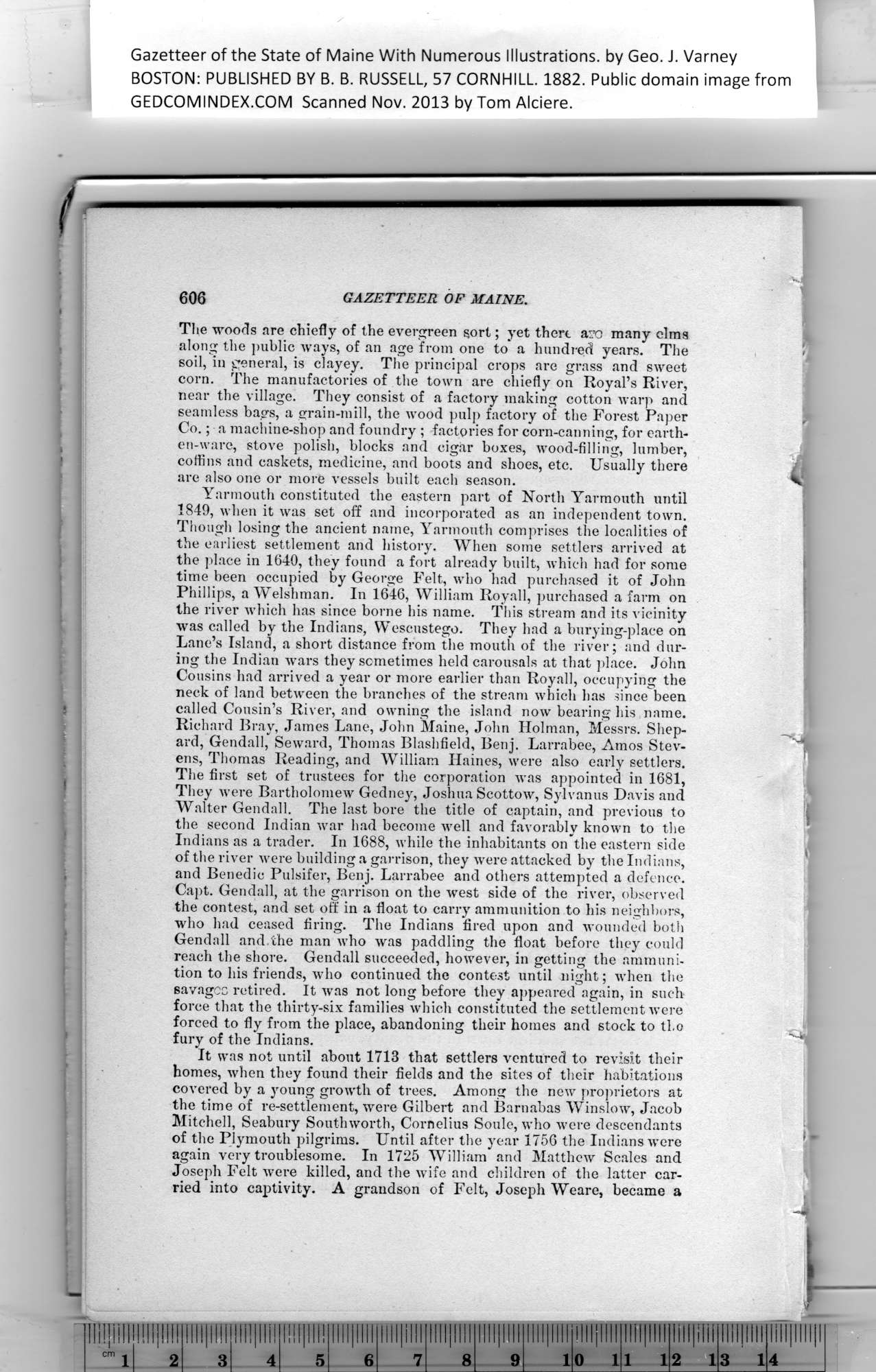|
Gazetteer of the State of Maine With Numerous Illustrations, by Geo. J. Varney
BOSTON: PUBLISHED BY B. B. RUSSELL, 57 CORNHILL. 1882. Public domain image from
606 GAZETTEER OF MAINE.
The woods are chiefly of the evergreen sort; yet there aro many elms
along the public ways, of an age from one to* a hundred years. The »,
soil, in general, is clayey. The principal crops are grass and sweet
corn. The manufactories of the town are cliiefly on Royal’s River,
near the village. They consist of a factory making cotton warp and
seamless bags, a grain-mill, the wood pulp factory of the Forest Paper
Co.; a machine-shop and foundry ; factories for corn-canning, for earth-
en-ware, stove polish, blocks and cigar boxes, wood-filling, lumber,
coffins and caskets, medicine, and boots and shoes, etc. Usually there
are also one or more vessels built each season.
Yarmouth constituted the eastern part of North Yarmouth until
1849, when it was set off and incorporated as an independent town.
Though losing the ancient name, Yarmouth comprises the localities of
the earliest settlement and history. When some settlers arrived at
the place in 1640, they found a fort already built, which had for some
time been occupied by George Felt, who had purchased it of John
Phillips, a Welshman. In 1646, William Royall, purchased a farm on
the river which has since borne his name. This stream and its vicinity
was called by the Indians, Wescustego. They had a burying-place on
Lane’s Island, a short distance from the month of the river; and dur-
ing the Indian tvars they sometimes held carousals at that place. John
Cousins had arrived a year or more earlier than Royall, occupying the
neck of land between the branches of the stream which has since been
called Cousin’s River, and owning the island now bearing his name.
Richard Bray, James Lane, John Maine, John Holman, Messrs. Shep-
ard, Gendall, Seward, Thomas Blashfield, Benj. Larrabee, Amos Stev-
ens, Thomas Reading, and William Haines, were also early settlers. '
The first set of trustees for the corporation was appointed in 1681,
They were Bartholomew Gedney, Joshua Scottow, Sylvanus Davis and
Walter Gendall. The last bore the title of captain, and previous to
the second Indian war had become well and favorably known to the
Indians as a trader. In 1688, while the inhabitants on the eastern side
of the river were building a garrison, they were attacked by the Indians,
and Benedic Pulsifer, Benj. Larrabee and others attempted a defence.
Capt. Gendall, at the garrison on the wrest side of the river, observed
the contest, and set off in a float to carry ammunition to his neighbors,
who had ceased firing. The Indians fired upon and wounded botli
Gendall and the man who was paddling the float before they could
reach the shore. Gendall succeeded, however, in getting the ammuni-
tion to his friends, who continued the contest until night; when the
savagee retired. It was not long before they appeared again, in such
foi ■ce that the thirty-six families which constituted the settlement were
forced to fly from the place, abandoning their homes and stock to tl.o
fury of the Indians.
It was not until about 1713 that settlers ventured to revisit their
homes, when they found their fields and the sites of their habitations
covered by a young growth of trees. Among the new proprietors at
the time of re-settlement, were Gilbert and Barnabas Winslow, Jacob
Mitchell, Seabury Sonthworth, Cornelius Soule, who were descendants :
of the Plymouth pilgrims. Until after the year 1756 the Indians ■were *
again very troublesome. In 1725 William and Matthew Scales and
Joseph Felt were killed, and the wife and children of the latter car-
ried into captivity. A grandson of Felt, Joseph Weare, became a
PREVIOUS PAGE ... NEXT PAGE
This page was written in HTML using a program written in Python 3.2
|
